Introduction
Plantar Fasciitis is a common and painful foot condition that affects millions of people worldwide. It occurs when the plantar fascia, a thick band of tissue that runs along the bottom of your foot, becomes inflamed or irritated. The symptoms include stabbing pain in the heel, especially in the morning or after periods of inactivity. While plantar fasciitis can be a persistent and debilitating condition, there are ways to alleviate its symptoms and even cure it within one week.
Early Recognition and Rest
The first step in curing plantar fasciitis in one week is to recognize the condition early and give your foot the rest it needs. Ignoring the pain and continuing with regular activities can exacerbate the condition. Start by reducing or avoiding activities that put strain on your feet, such as running or standing for long periods.
Ice Therapy
Applying ice to the affected area can help reduce inflammation and relieve pain. Ice the heel for 15-20 minutes several times a day, especially after periods of activity or when the pain flares up. Make sure to wrap the ice pack in a cloth to prevent frostbite.
Stretching Exercises
Regular stretching exercises can significantly improve plantar fasciitis symptoms. Perform simple stretches for the calf muscles and Achilles tendon to relieve tension on the plantar fascia. You can use a towel or a resistance band for added support. Stretching should be done gently and consistently throughout the day.
Footwear
Wearing appropriate footwear is crucial for a speedy recovery. Invest in shoes with good arch support and cushioning to reduce strain on the plantar fascia. Avoid flat shoes or those with inadequate support. Consider using orthotic inserts to provide extra comfort and support.
Night Splints
Night splints are designed to keep your foot dorsiflexed (toes pointed upward) while you sleep. This helps stretch the plantar fascia, reducing morning pain. Using night splints consistently can accelerate the healing process.
Anti-Inflammatory Medication
Over-the-counter non-steroidal anti-inflammatory drugs (NSAIDs) like ibuprofen can help alleviate pain and reduce inflammation. However, consult with a healthcare professional before using any medication, as long-term or excessive use may have adverse effects.
Massage and Foam Rolling
Massage and foam rolling can help relieve tension in the plantar fascia and surrounding muscles. Roll a tennis ball or a frozen water bottle under your foot for a few minutes each day to break up knots and improve circulation.
Taping Techniques
Athletic tape or kinesiology tape can provide additional support to the arch and reduce tension on the plantar fascia. Consult a physical therapist or healthcare provider to learn proper taping techniques.
Gentle Exercises
While high-impact activities should be avoided, gentle exercises like swimming and cycling can maintain cardiovascular fitness without putting excessive strain on the affected area.
Maintain a Healthy Weight
Excess body weight can exacerbate plantar fasciitis. Losing weight, if necessary, can reduce the pressure on your feet and improve your recovery.
Consult a Professional
If your symptoms persist or worsen, it’s essential to consult a healthcare professional. They can provide you with a personalized treatment plan, which may include physical therapy, custom orthotics, or corticosteroid injections.
FREQUENTLY ASKED QUESTIONS
Can plantar fasciitis heal in a week?
You should notice your plantar fasciitis symptoms improving as soon as you start treating them. But it can take anywhere from a few weeks to a few months for your plantar fascia to heal. If you feel better but then your symptoms return, try the same at-home treatments you used before.
Is plantar fasciitis permanent?
Far from being a permanent or chronic condition, plantar fasciitis typically responds well to treatment. Most people recover completely with a few months of conservative treatment. And, you have lots of options available to you. Many cases of plantar fasciitis respond positively to conservative treatment strategies.
Is walking a lot bad for plantar fasciitis?
In fact, walking may actually inflame the plantar fascia more, leading to an extension of your treatment. While it’s not walking alone that could further inflame the ligament, if you’re not wearing the right shoes or are exerting yourself too much, the plantar fasciitis can flare up.
Conclusion
Curing plantar fasciitis in one week is a challenging goal, but with consistent effort and a combination of the strategies mentioned above, you can significantly reduce pain and discomfort within that time frame. Remember that everyone’s body responds differently, so it’s essential to listen to your body and adjust your treatment plan accordingly. Early intervention and a commitment to self-care are key to a speedy recovery from plantar fasciitis. Always consult a healthcare professional for guidance and support in managing this condition.
Read Also : Unearth The Secrets How to Make Plants in Little Alchemy 2



